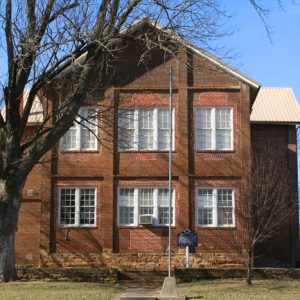calsfoundation@cals.org
Fontaine Richard Earle (1831–1908)
Fontaine Richard Earle was a major in the Thirty-fourth Arkansas Infantry (CSA) from Cane Hill (Washington County). He fought in a number of Civil War battles in the Trans-Mississippi Theater and later served northwest Arkansas as a legislator (1866–1867), minister, teacher, administrator, and author.
Fontaine R. Earle was born on January 9, 1831, in Pond River, Kentucky. His parents, Samuel Baylis Earle and Jane Woodson Earle, were farmers in Pond River; he had eight siblings. Earle received bachelor’s degrees in arts and divinity from Cumberland University in Lebanon, Tennessee, in 1858. He moved to Boonsboro (now Cane Hill) in 1859 to become president of Cane Hill College and a Cumberland Presbyterian minister. During the Civil War, he became engaged to a fellow preacher’s daughter, Amanda Buchanan, but the couple waited until the end of the war to marry. Earle closed Cane Hill College in the spring of 1861, signed up as a private with the Arkansas militia, and fought at the Battle of Wilson’s Creek in Missouri (August 10, 1861). After the battle, Earle declined to be transferred into the Confederate army and returned to Arkansas.
After his defeat at the Battle of Pea Ridge in March 1862, Major General Earl Van Dorn moved his Confederate army east of the Mississippi River, leaving northwest Arkansas without military protection. The Confederate government appointed Major General Thomas C. Hindman to head the Department of the Trans-Mississippi in June 1862, with his headquarters based in Little Rock (Pulaski County). His call for volunteers led Earle to raise a company of men, mostly residents of Cane Hill, which formed Company B of the Thirty-fourth Arkansas Infantry. Earle was elected captain, and his men trained with the Thirty-fourth Arkansas under Colonel William H. Brooks in Elm Springs (Washington and Benton counties). Brooks’s regiment merged with other Arkansas regiments into a brigade under General James Fagan, serving in a division commanded by General Francis Shoup. As part of an army of 12,000 men, Capt. Earle marched northward out of Van Buren (Crawford County) on December 3 to confront Union general James Blunt’s Army of the Frontier at Prairie Grove (Washington County).
General Hindman’s official report does not mention Col. Brooks’s outfit, but the Thirty-fourth fought hard and sustained heavy casualties during the December 7, 1862, Battle of Prairie Grove. Capt. Earle reported six casualties for B Company. In the thick of fighting in the orchard behind Archibald Borden’s house, a bullet pierced the back of Earle’s kepi, scraping his scalp but leaving him otherwise unharmed. Inspecting the damage to his cap, he remarked, “That was a pretty close clipping.” When told that if the bullet had been an inch closer, he would have been killed, Earle replied that if it had been an inch the other direction, it would have missed him entirely.
On July 4, 1863, the Thirty-fourth Arkansas participated in a failed assault on Union-controlled Helena (Phillips County). Company B and Capt. Earle particularly were commended “for the steadiness with which they advanced, drove the enemy before them, and maintained their positions under a heavy artillery fire.” The Thirty-fourth wintered in Camden (Ouachita County), and Earle was promoted to major in December 1863.
The Thirty-fourth’s next major engagement was on April 30, 1864, at Jenkins’ Ferry on the Saline River, between Camden and Little Rock. During the fighting, command of the Thirty-fourth fell to Earle when all of his superiors were wounded. B Company suffered five casualties, including Earle’s future brother-in-law, Albert Buchanan. Earle remained in command of the Thirty-fourth until the end of the war but saw no more action, his army remaining on the march between Arkansas, Louisiana, and Texas.
Earle’s first inclination upon learning of the Confederacy’s surrender was to expatriate to Mexico. However, he decided to march the Thirty-fourth to Fort Smith (Sebastian County), where he surrendered on June 9, 1865. Within six days, he was back in Cane Hill and married to Amanda Buchanan.
Elected to Arkansas’s state legislature from Washington County in 1866, he pushed through the state’s first bill for free public schooling and was later elected as the state’s first secretary of education (then called Superintendent of Public Instruction). Earle published a grammar book in 1867. He rebuilt Cane Hill College, which had been burned during the war, and served as its president until it closed in 1892, after which he devoted his life to preaching. For a short while, he served as president of Cumberland College (now the University of the Ozarks) in Clarksville (Johnson County).
Earle died at home in Cane Hill on September 6, 1908, and is buried at the Cane Hill Cemetery.
For additional information:
McColloch, Clem. “History of the 34th Confederate Regiment.” Flashback 12 (December 1962): 5–13.
Waterman, Robert E., and Thomas Rothrock, eds. “The Earle-Buchanan Letters of 1861–1876.” Arkansas Historical Quarterly 33 (Summer 1974): 99–174.
Chester Cornell
University of Arkansas, Fayetteville


 Cane Hill College
Cane Hill College 



Glad Richard Earle survived. To give Arkansas free education is big. To lead these men the last days of the war surely needed an educated man of Christianity. I feel sad folks were so sure of the war; we all suffer today because the lost footing folks like Richard Earle had for us before the war. When I drive past Coal Hill on I-40 I smile we had such a man as Richard Earle.